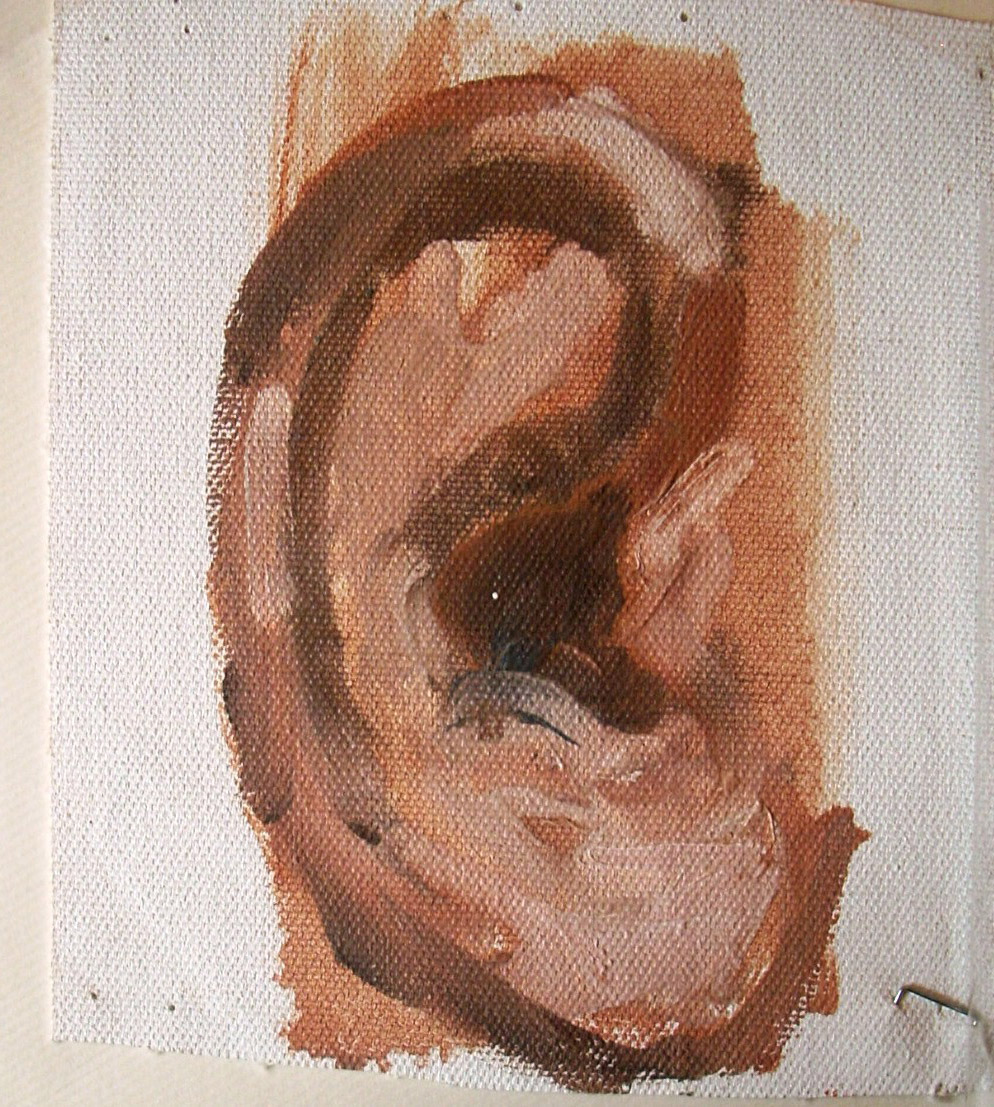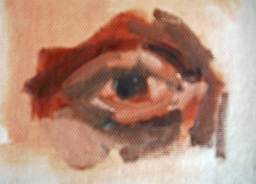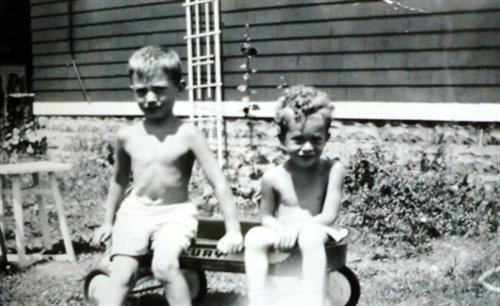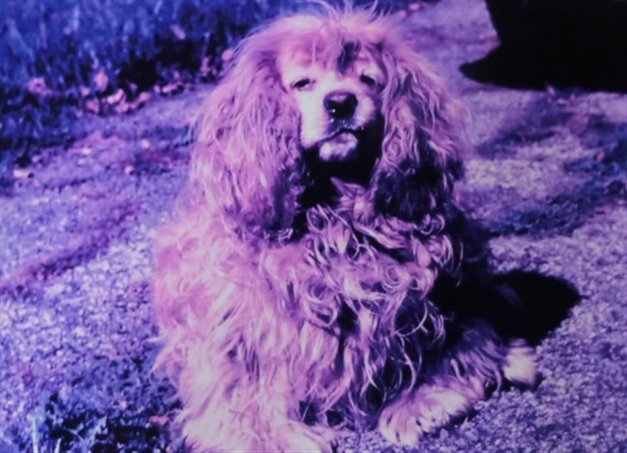Life is an Ear Ache
As a child I had the most terrible ear infections. Every winter had me with my ear to the radiator and sometimes using bags of heated salt to press against my ear. The pain was excruciating. I took in ear drops. I am sure this exasperated my already sensitive nature. I was very thin and had that skinny look, often swimming in my trousers. Eventually I had to have my adenoids and tonsils taken out to prevent further earaches. I remember the ether mask being applied, then loud gongs going off in my head, then nothing. I recovered at home eating cold vanilla ice cream to sooth my sore throat.
I had other childhood afflictions. I always had painful eyes that were diagnosed as a severe astigmatism. I was supposed to take the bus all the way downtown for “eye exercises” to help cure the affliction. This never happened except maybe twice. Instead I got glasses to correct the problem. But my eyes still hurt a lot, especially in bad weather.
A scarier episode was my brush with polio. I remember the Stone family living way down the street going towards Military Avenue. The mother was in a wheel chair from childhood paralysis. The house was painted pure white and inside as well, it seemed like a hospital. Such were my mental associations with disabilities and fears of polio.
Well that summer (was I now twelve years old?) was the big polio scare. Anyway towards the end of the summer after returning from a swim at Crystal Beach (on the Canadian side where an aunt had a small cabin), I suddenly developed a weak hip and had difficulty walking. My parents were worried about polio and, when the condition seemed to get worse after a few days, I found myself at Dr. Adler’s office (our family doctor with an office in Kenmore but later relocated to near Delaware Park). The doctor said I probably had a “brush with” polio but it was a weak strain of the virus and it had caused no permanent damage, just a very scary episode.
Sidney and Ronnie living in the Housing Projects
Dr. Adler, as it turned out, played a significant role in my life in another way. When my parents were living in Oregon where I had transplanted them from Buffalo, I had occasion to talk to them about circumstances surrounding my birth and early days in Buffalo. This has already been mentioned but just to reiterate:
My father admitted that after he found out about my Mother’s mental illness, concealed from him by her family at the time of the marriage, he had tried to have my birth aborted.
He already had one son (Ronnie) and didn’t want to chance bringing another schizophrenia victim into the world. Such was the stigma of inherited mental illness in those days (the 1940’s), that he asked Dr. Adler to give my mother something to abort the baby. Somehow he browbeat Jeanette into going along with this (she corroberated the story on her own when asked.).
Fortunately for me the “medicine”, whatever it was, didn’t work. I was born! I popped out May 11th, 1944 as “Gerald Joel Gross”, as I was named. As mentioned above, my parents, at that time, were living on no. 17 Harbor Walk, in Buffalo. These were “projects” for serviceman. My father was stationed out of town, however, in Oshkosh, Wisconsin, where he was a “Sergeant Bilko” type drill officer in the air force. Of course he had many stories to tell about his service.
He told the story of how he so admired the drill sergeants that he would lean against a fence watching and trying to imitate their calls. Attention! Parade Rest!! Lefffft face! Forrrward Harsh! After a while he had memorized both the words used and the intonations in their voices as they commanded the troops to march forward, turn, or do an about face. One day when all the men were lined up the officer in charge asked for volunteers to step forward to take command of the drilling of the men.
Sidney stepped forward without hesitation. He immediately saluted the troops and began to bark out drill commands. Thus in an instant, he was given the status of “Drill Sergeant” which lasted for the duration of the war.
But that’s only half the story. As he told it, he was given all the baseball teams who were being pressed into service to entertain the troops with exhibition games. I don’t recall the details but they were treated with an element of diffidence and allowed to gamble and carry on much like in the Sergeant Bilko television show. When one soldier in particular was giving Sidney a hard time and threatening to beat him up for whatever reason, a professional boxer who was assigned to his bunkhouse interceded in his defense. Sidney had no further problems from his tormentor.
And there was no end to the bullshitting stories as well. When asked how he lost his teeth while in the service, he told the story of being hit in the jaw by an airplane propeller. When the truth came out, it was the poor dentistry provided to servicemen in those days, where they would rather pull all the teeth out and issue false teeth rather than drilling and treating bad teeth. Somehow the propeller story sounded more romantic.
Prior to, and after getting out of the service, Sidney worked as a fur salesman at N.L. Kaplan Furs Inc. in downtown Buffalo. He worked with other salesmen like Max Perlman. The owner’s son was name Eugene Kaplan. I remember company hay rides out at the owner’s ranch, somewhere in the countryside outside of Buffalo. A good time had by all with cook outs, corn on the cob, and all that good old company patronisim characteristic of retail sales organizations.
But my father was very dissatisfied with his position in the firm. There was no advancement to speak of; just a salary and I suppose (not verified) commission on sales. One of my father’s favorite books was Arthur Miller’s “Death of a Salesman.” Whenever it was on television the entire family was glued to the screen and we imagined a similar fate for our Sidney.
One day Sidney announced he was taking a chance and opening his own store. Maybe he had gotten lucky at the track that summer? He had all the names of what he called his “schwartza” (black) customers. These were N.L. Kaplan customers who would store their fur coats for “hollanderizing” for the summer.
This mysterious process consisted in rolling the furs inside of drums filled with sawdust to clean the coats. Apparently my father was always given the somewhat arduous task of calling on and gathering up the coats throughout the black ghetto, which was substantial. He was fond of telling us that he would call upon a family with nothing but orange crates for furniture but there would be one or more furs to collect for storage. We instinctively knew this story had a racist element but, at the time, we could only absorb it all as part of the overall racist context in which we existed.
Buffalo was a very segregated society by race and by class. There were large Polish, Afro-American, Irish, Italian, and Jewish neighborhoods. This extended somewhat out to the suburbs which were almost entirely white. In the suburbs the demarcations were mostly by class, not ethnicity. Within the community of Kenmore and the Town of Tonawanda where we lived, however, ethnicity played an import role. This was especially evident when Sidney vented his prejudices in almost Archie Bunker style outbursts, as we shall see.
On the other hand, he was never drunk and was a “good provider” in the sense that we never went hungry or without school clothes. He did have a volatile temper, however, and would often thrash Ronnie and me with his belt. Ronnie would hide in the bathroom for hours until the coast was clear.
Ronnie and Jerry in backyard of Girard Blvd house
where anti-Semitic graffiti was written.
Candy, the Family Dog
Our long-suffering cocker spaniel “Candy” who was hit by cars in front of our house several times and who had to endure the cold hallway where she was made to sleep during long winters. She was a good companion and pet and I really loved her.




